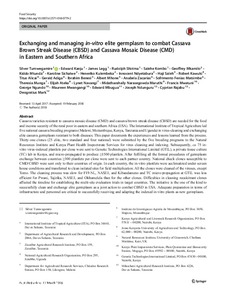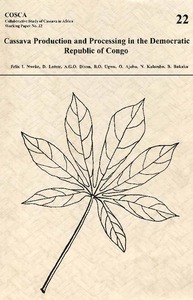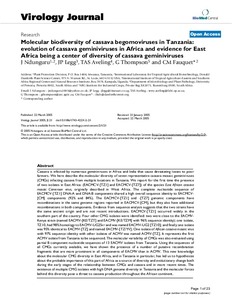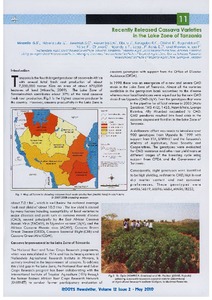| dc.contributor.author | Tumwegamire, S. |
| dc.contributor.author | Kanju, E. |
| dc.contributor.author | Legg, J.P. |
| dc.contributor.author | Shirima, R. |
| dc.contributor.author | Kombo, S. |
| dc.contributor.author | Mkamilo, G.S. |
| dc.contributor.author | Mtunda, K. |
| dc.contributor.author | Sichalwe, K. |
| dc.contributor.author | Kulembeka, H.P. |
| dc.contributor.author | Ndyetabura, I. |
| dc.contributor.author | Saleh, H. |
| dc.contributor.author | Kawuki, R. |
| dc.contributor.author | Alicai, Titus |
| dc.contributor.author | Adiga, G. |
| dc.contributor.author | Benesi, I. |
| dc.contributor.author | Mhone, A. |
| dc.contributor.author | Zacarias, A. |
| dc.contributor.author | Matsimbe, S.F. |
| dc.contributor.author | Munga, T. |
| dc.contributor.author | Ateka, E. |
| dc.contributor.author | Navangi, L. |
| dc.contributor.author | Maruthi, M.N. |
| dc.contributor.author | Mwatuni, F. |
| dc.contributor.author | Ngundo, G. |
| dc.contributor.author | Mwangangi, M. |
| dc.contributor.author | Mbugua, E. |
| dc.contributor.author | Ndunguru, J. |
| dc.contributor.author | Rajabu, C. |
| dc.contributor.author | Mark, D. |
| dc.date.accessioned | 2019-12-04T11:19:12Z |
| dc.date.available | 2019-12-04T11:19:12Z |
| dc.date.issued | 2018 |
| dc.identifier.citation | Tumwegamire, S., Kanju, E., Legg, J., Shirima, R., Kombo, S., Mkamilo, G., ... & Mark, D. (2018). Exchanging and managing in-vitro elite germplasm to combat cassava brown streak disease (CBSD) and cassava mosaic disease (CMD) in Eastern and Southern Africa. Food Security, 1-18. |
| dc.identifier.issn | 1876-4517 |
| dc.identifier.uri | https://hdl.handle.net/20.500.12478/3417 |
| dc.description | Article purchased; Published online: 17 March 2018 |
| dc.description.abstract | Cassava varieties resistant to cassava mosaic disease (CMD) and cassava brown streak disease (CBSD) are needed for the food and income security of the rural poor in eastern and southern Africa (ESA). The International Institute of Tropical Agriculture led five national cassava breeding programs (Malawi, Mozambique, Kenya, Tanzania and Uganda) in virus-cleaning and exchanging elite cassava germplasm resistant to both diseases. This paper documents the experiences and lessons learned from the process. Thirty-one clones (25 elite, two standard and four national) were submitted by the five breeding programs to the Natural Resources Institute and Kenya Plant Health Inspectorate Services for virus cleaning and indexing. Subsequently, ca 75 in-vitro virus-indexed plantlets per clone were sent to Genetic Technologies International Limited (GTIL), a private tissue culture (TC) lab in Kenya, and micro-propagated to produce ≥1500 plantlets. After fulfilling all the formal procedures of germplasm exchange between countries ≥300 plantlets per clone were sent to each partner country. National check clones susceptible to CMD/CBSD were sent only to their countries of origin. In each country, the in-vitro plantlets were acclimatized under screen house conditions and transferred to clean isolated sites for field multiplication. All the clones were cleaned of the viruses, except Tomo. The cleaning process was slow for F19-NL, NASE1, and Kibandameno and TC micro-propagation at GTIL was less efficient for Pwani, Tajirika, NASE1, and Okhumelela than for the other clones. Difficulties in cleaning recalcitrant clones affected the timeline for establishing the multi-site evaluation trials in target countries. The initiative is the one of the kind to successfully clean and exchange elite germplasm as a joint action to combat CBSD in ESA. Adequate preparation in terms of infrastructure and personnel are critical to successfully receiving and adapting the indexed in-vitro plants as new germplasm. |
| dc.description.sponsorship | Bill & Melinda Gates Foundation |
| dc.format.extent | 1-18 |
| dc.language.iso | en |
| dc.subject | Cassava |
| dc.subject | Exchange |
| dc.subject | In Vitro |
| dc.subject | Germplasm |
| dc.subject | Plant Diseases |
| dc.subject | Cassava Varieties |
| dc.subject | African Cassava Mosaic Virus |
| dc.subject | Cassava Brown Streak Disease |
| dc.title | Exchanging and managing in-vitro elite germplasm to combat cassava brown streak disease (CBSD) and cassava mosaic disease (CMD) in Eastern and Southern Africa |
| dc.type | Journal Article |
| dc.description.version | Peer Review |
| cg.contributor.crp | Roots, Tubers and Bananas |
| cg.contributor.affiliation | International Institute of Tropical Agriculture |
| cg.contributor.affiliation | Department of Agricultural Research and Development, Tanzania |
| cg.contributor.affiliation | Zanzibar Agricultural Research Institute, Tanzania |
| cg.contributor.affiliation | National Agricultural Research Organisation, Uganda |
| cg.contributor.affiliation | Department for Agricultural Research Services, Malawi |
| cg.contributor.affiliation | Instituto de Investigacao Agraria de Mocambique, Mozambique |
| cg.contributor.affiliation | Kenya Agricultural and Livestock Research Organization |
| cg.contributor.affiliation | Jomo Kenyatta University of Agriculture and Technology |
| cg.contributor.affiliation | University of Greenwich |
| cg.contributor.affiliation | Kenya Plant Inspectorate Services |
| cg.contributor.affiliation | Genetic Technologies International Limited, Kenya |
| cg.contributor.affiliation | Mikocheni Agricultural Research Institute, Tanzania |
| cg.coverage.region | Africa |
| cg.coverage.region | East Africa |
| cg.coverage.region | Southern Africa |
| cg.coverage.country | Kenya |
| cg.coverage.country | Malawi |
| cg.coverage.country | Mozambique |
| cg.coverage.country | Tanzania |
| cg.coverage.country | Uganda |
| cg.creator.identifier | Silver Tumwegamire: 0000-0003-2820-6337 |
| cg.creator.identifier | Edward Kanju: 0000-0002-0413-1302 |
| cg.creator.identifier | James Legg: 0000-0003-4140-3757 |
| cg.researchtheme | BIOTECH & PLANT BREEDING |
| cg.researchtheme | PLANT PRODUCTION & HEALTH |
| cg.isijournal | ISI Journal |
| cg.authorship.types | CGIAR and developing country institute |
| cg.iitasubject | Cassava |
| cg.iitasubject | Plant Breeding |
| cg.iitasubject | Plant Diseases |
| cg.iitasubject | Plant Genetic Resources |
| cg.iitasubject | Plant Health |
| cg.iitasubject | Plant Production |
| cg.journal | Food Security |
| cg.howpublished | Formally Published |
| cg.accessibilitystatus | Open Access |
| local.dspaceid | 95209 |
| cg.targetaudience | Scientists |
| cg.identifier.doi | http://dx.doi.org/10.1007/s12571-018-0779-2 |




